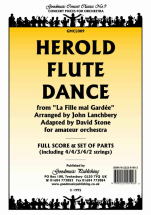Flute Dance
Buy this item (out of stock)
Product ID: GM1 CL009
By Ferdinand (Louis Joseph) Hérold
Publisher:
Goodmusic
Arranger:
Lanchbery & Stone
Series:
Concert Classics
Genre:
Romantic Era
Line Up:
Symphony Orchestra
Duration:
2:00
Level: 3
Set & Score
This item is out of stock
About this item
Another piece from "La Fille mal Gardee" (also see GMCL004 The Clog Dance). Minimum forces required for performance are 1 flute, 1 oboe, 1 clarinet and strings. The piano part may be used to strengthen the lower strings and also as an aid to rehearsal. The piccolo should be played by the 2nd flute if possible. If no piccolo is available then the part may be played as it stands by a flute. If only one flautist is available it would be best to play the 1st flute part. If only 1 bassoon is available the 1st bassoon part should be played where the 2nd is silent, but 2nd where both are playing.
Instrumentation
2 Flutes (2nd doubling piccolo), 2 Oboes, 2 Clarinets in Bb, 2 Bassoons 2 Horns in F, 2 Trumpets in Bb, 3 Trombones, Timpani, Perc. (Side drum, Triangle, Bass drum, Cymbals) Strings (Violin 1, Violin 2, Viola, Cello, Bass) Piano (optional)
Reviews and rating
No review available, be the first to write one!

Composer
Ferdinand (Louis Joseph) Hérold
Louis Joseph Ferdinand Hérold, better known as Ferdinand Hérold, pronounced: [fɛʁdinɑ̃ eʁɔld], (January 28, 1791 – January 19, 1833) was a French operatic composer of Alsatian descent who also wrote many pieces for the piano, orchestra, and the ballet. He is best known today for the ballet La fille mal gardée and the overture to the opera Zampa.
L.J.F. Hérold was born in Paris, the only child of François-Joseph Hérold, a pianist and composer, and Jeanne-Gabrielle Pascal. He was the grandson of Nicolas Hérold, an organist. At the age of six, he attended the Hix Institute and excelled in his studies. While there, he also took musical theory with François-Joseph Fétis (who later edited the periodical La Revue Musicale). At the age of seven, he played piano and composed some piano pieces.
Hérold's father did not intend for him to follow a musical career, but after his father's death in 1802, he could finally pursue this avenue. He enrolled in the Conservatoire in 1806 and was schooled in piano by Louis Adam (father of the composer Adolphe Adam). He also was instructed by Charles Simon Catel (in harmony), Rodolphe Kreutzer (in violin), and Étienne Méhul (in composition). Hérold during these times at the Conservatoire became a virtuoso on piano and violin.
More info about the composer...



 Click above to view samples
Click above to view samples
